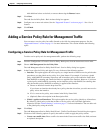
1-7
Cisco ASA Series Firewall ASDM Configuration Guide
Chapter 1 Configuring a Service Policy
Default Settings
• You can only apply one global policy. For example, you cannot create a global policy that includes
feature set 1, and a separate global policy that includes feature set 2. All features must be included
in a single policy.
• When you make service policy changes to the configuration, all new connections use the new service
policy. Existing connections continue to use the policy that was configured at the time of the
connection establishment. show command output will not include data about the old connections.
For example, if you remove a QoS service policy from an interface, then re-add a modified version,
then the show service-policy command only displays QoS counters associated with new
connections that match the new service policy; existing connections on the old policy no longer
show in the command output.
To ensure that all connections use the new policy, you need to disconnect the current connections so
they can reconnect using the new policy. See the clear conn or clear local-host commands.
Default Settings
The following topics describe the default settings for Modular Policy Framework:
• Default Configuration, page 1-7
• Default Traffic Classes, page 1-8
Default Configuration
By default, the configuration includes a policy that matches all default application inspection traffic and
applies certain inspections to the traffic on all interfaces (a global policy). Not all inspections are enabled
by default. You can only apply one global policy, so if you want to alter the global policy, you need to
either edit the default policy or disable it and apply a new one. (An interface policy overrides the global
policy for a particular feature.)
The default policy includes the following application inspections:
• DNS
• FTP
• H323 (H225)
• H323 (RAS)
• RSH
• RTSP
• ESMTP
• SQLnet
• Skinny (SCCP)
• SunRPC
• XDMCP
• SIP
• NetBios
• TFTP


















